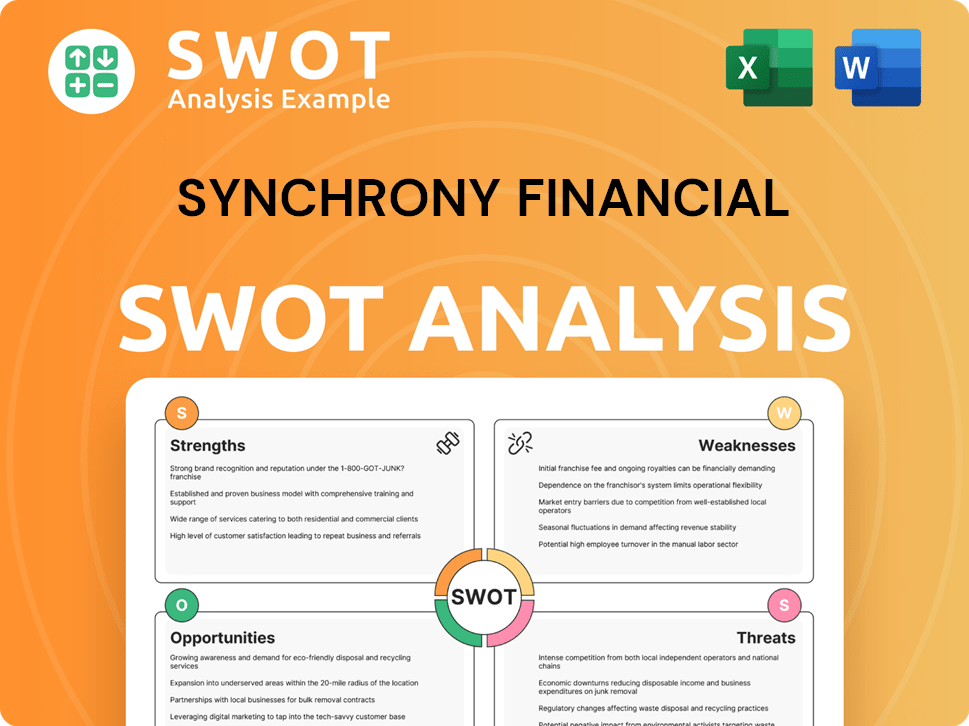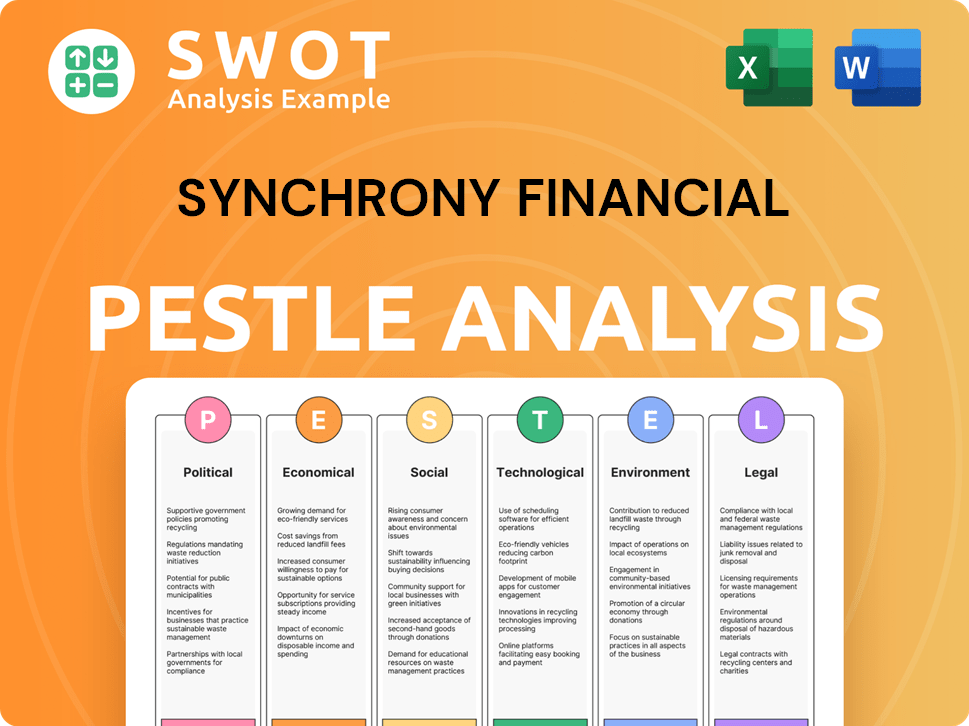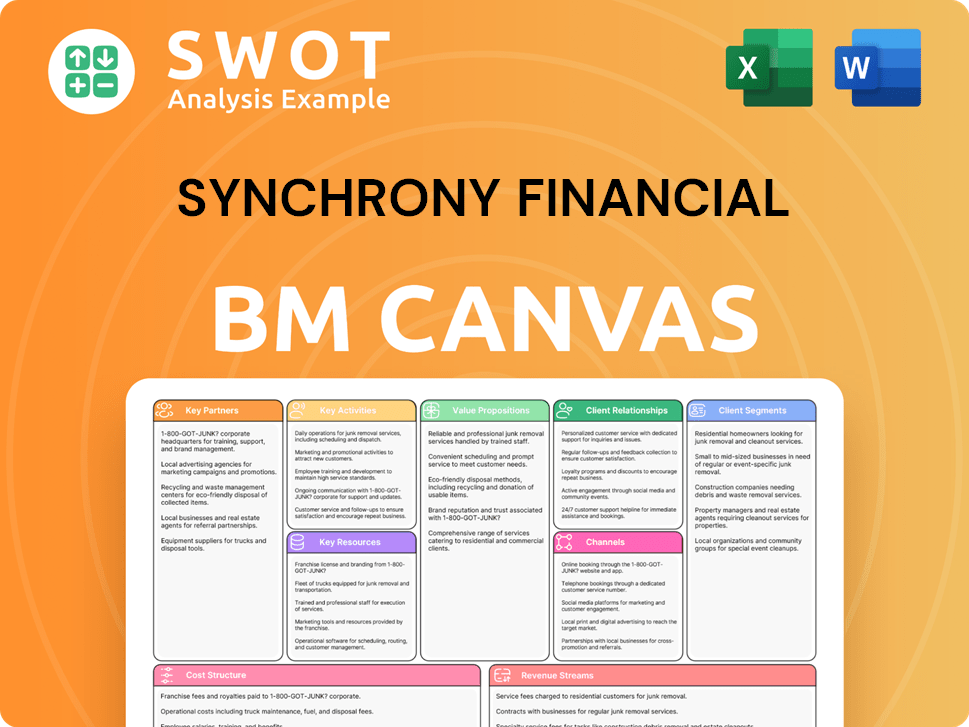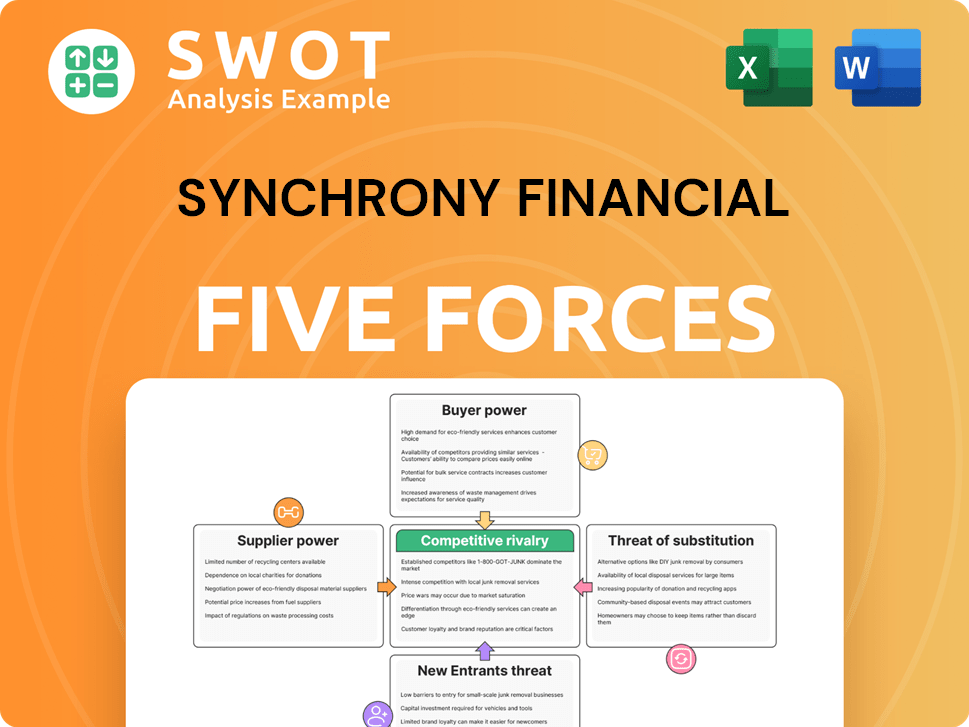Synchrony Financial Bundle
How Does Synchrony Financial Thrive in the Credit Card Market?
Synchrony Financial, a titan in the financial services sector, empowers businesses with tailored credit solutions. Born from GE Capital Retail Finance, it swiftly became a leader in private label and co-branded credit cards. Synchrony's influence spans retail, healthcare, and more, making it a crucial partner for businesses aiming to boost sales and loyalty through flexible financing.

This exploration of Synchrony Financial SWOT Analysis will dissect how this credit card company operates, generates revenue, and manages risk. Understanding Synchrony's strategies is vital for investors, businesses, and anyone tracking the evolution of financial services. We'll examine the inner workings of Synchrony Bank, its diverse financial products, and how it maintains its competitive edge in the dynamic world of finance, including details on Synchrony credit card offerings and Synchrony Bank credit card application processes.
What Are the Key Operations Driving Synchrony Financial’s Success?
Synchrony Financial creates value by partnering with businesses to offer customized credit products. They provide private label credit cards, co-branded cards, and installment loans. These services cater to a wide range of customers, from those seeking flexible payment options to individuals needing financing for significant purchases in sectors such as health, home, and auto.
The operational processes are multifaceted, starting with technology for credit applications, account management, and digital payment solutions. Synchrony uses data analytics and AI to assess creditworthiness, manage risk, and personalize customer experiences. Sales involve direct engagement with retailers, developing credit programs that integrate with their systems. Customer service is handled through online portals, mobile apps, and call centers.
The supply chain focuses on data flow, regulatory compliance, and financial capital. Partnerships with retailers are central, defining the credit product offerings. Distribution is embedded within partners' storefronts. Synchrony's deep integration with partners' sales processes, coupled with its credit risk management expertise, allows it to offer customized financing solutions that increase sales and customer loyalty. Read more about Owners & Shareholders of Synchrony Financial.
Synchrony Financial offers a range of credit card products, including private label, co-branded, and installment loans. Private label cards are exclusive to specific retailers, while co-branded cards feature a major payment network. Installment loans provide financing for larger purchases. These options cater to diverse financial needs.
Synchrony's operations involve technology for credit applications and account management. They leverage data analytics and AI for risk assessment and customer experience personalization. Sales involve direct engagement with retailers, integrating credit programs into their systems. Customer service is provided through multiple channels.
The supply chain focuses on data flow and financial capital. Partnerships with retailers are crucial, defining the credit product offerings. Distribution is integrated within partners' storefronts. This integration, along with credit risk management, enables customized financing solutions.
Synchrony offers customized financing solutions, increasing sales and customer loyalty for its partners. Their expertise in managing credit risk and integrating with partners' sales processes differentiates them in the market. This results in enhanced financial performance for both Synchrony and its partners.
In 2024, Synchrony Financial reported significant financial results. The company's net interest income was substantial, reflecting its core lending operations. These figures highlight Synchrony’s financial strength and its ability to manage credit risk effectively.
- Net interest income is a primary revenue source.
- The company's loan portfolio is diverse, mitigating risk.
- Efficiency initiatives have improved profitability.
- Digital transformation continues to drive operational improvements.
Synchrony Financial SWOT Analysis
- Complete SWOT Breakdown
- Fully Customizable
- Editable in Excel & Word
- Professional Formatting
- Investor-Ready Format

How Does Synchrony Financial Make Money?
Synchrony Financial, a prominent credit card company, generates revenue through a multifaceted approach. Its primary revenue streams include interest income, interchange fees, and various other fees associated with its financial products. This diversified strategy allows the company to maintain financial stability and adapt to market changes.
The company's revenue model is designed to maximize profitability and customer engagement. By focusing on strategic partnerships and innovative financial products, Synchrony aims to enhance its market position and provide value to its stakeholders. This approach has enabled it to remain competitive in the dynamic financial services industry.
In the first quarter of 2024, Synchrony reported net interest income of $4.0 billion, highlighting the significance of interest earned on outstanding balances. Additionally, interest and fees on loans for the same period amounted to $4.9 billion, showcasing another crucial revenue source. This demonstrates the company's reliance on interest-based income from its Synchrony credit card and loan portfolios.
Synchrony Financial employs several strategies to generate revenue and maintain profitability. These strategies are designed to optimize revenue streams and enhance customer engagement. For a deeper dive into their strategic growth, consider reading about the Growth Strategy of Synchrony Financial.
- Interest Income: The largest revenue source comes from interest charged on credit card balances and loans.
- Interchange Fees: Revenue is generated from fees paid by merchants for processing transactions on Synchrony credit card.
- Other Fees: Includes late fees, annual fees, and program fees from retail partners.
- Partner-Centric Approach: Collaborates with businesses to create tailored credit programs, often involving revenue-sharing agreements.
- Cross-selling and Upselling: Offers additional credit products and features to existing cardholders based on their spending habits.
- Digital Expansion: Enhances customer engagement and potential revenue through mobile payment solutions and online account management.
- Diversified Industry Segments: Operates across retail, health, auto, and home sectors to diversify revenue and reduce risk.
Synchrony Financial PESTLE Analysis
- Covers All 6 PESTLE Categories
- No Research Needed – Save Hours of Work
- Built by Experts, Trusted by Consultants
- Instant Download, Ready to Use
- 100% Editable, Fully Customizable

Which Strategic Decisions Have Shaped Synchrony Financial’s Business Model?
The journey of Synchrony Financial has been marked by significant milestones and strategic moves that have shaped its current operational and financial standing. A pivotal moment was its spin-off from GE Capital in 2014, which allowed Synchrony to focus solely on consumer finance and develop its independent brand and strategy. Subsequent key moves have included strategic partnerships with major retailers and healthcare providers, expanding its reach and diversifying its credit portfolios.
The company has built on its strong relationships with partners like Lowe's, Gap, and Sam's Club. Synchrony has also invested heavily in digital transformation, launching mobile apps and online tools to enhance customer experience and streamline operations. Operational challenges have included managing credit risk through economic cycles and adapting to evolving regulatory landscapes in consumer finance. For example, during periods of economic uncertainty, Synchrony has had to refine its underwriting criteria and collection strategies to mitigate potential credit losses.
The company has responded by leveraging its robust data analytics capabilities to make more informed lending decisions and by diversifying its portfolio across various industries to reduce concentration risk. Synchrony's competitive advantages are multifaceted. Its deep expertise in private label and co-branded credit, built over decades as part of GE Capital, provides a significant barrier to entry for new competitors. The company benefits from strong brand recognition within the retail finance sector and established relationships with a vast network of merchant partners.
The spin-off from GE Capital in 2014 was a critical turning point, establishing Synchrony Financial as an independent entity. This move allowed for a focused strategy on consumer finance. Strategic partnerships with major retailers and healthcare providers were crucial for expanding its market reach and diversifying its credit portfolios.
Investing in digital transformation, including mobile apps and online tools, has enhanced customer experience and streamlined operations. Adapting to economic cycles by refining underwriting and collection strategies has been essential. Leveraging data analytics for informed lending decisions and portfolio diversification has mitigated risk.
Deep expertise in private label and co-branded credit offers a significant barrier to entry. Strong brand recognition and established merchant partnerships are key advantages. Economies of scale enable efficient transaction processing and risk management. Technology leadership in data analytics and digital platforms allows for personalized credit offerings and efficient customer service.
In 2024, Synchrony continues to invest in emerging technologies like AI and machine learning to enhance fraud detection, personalize marketing, and improve operational efficiency. The company also actively explores new payment solutions and financing models to stay ahead of competitive threats and changing consumer preferences. For more details, check out the Brief History of Synchrony Financial.
As of Q1 2024, Synchrony Financial reported strong financial results, with a focus on managing credit quality and expanding its digital capabilities. The company's strategic partnerships continue to drive growth. Synchrony Bank maintains a significant presence in the consumer credit market, offering various credit card options.
- Total revenue for Q1 2024 was approximately $4.2 billion.
- Purchase volume increased, reflecting strong consumer spending.
- The company continues to invest in its digital platforms and customer service.
- Synchrony is focused on adapting to changing consumer behaviors and market dynamics.
Synchrony Financial Business Model Canvas
- Complete 9-Block Business Model Canvas
- Effortlessly Communicate Your Business Strategy
- Investor-Ready BMC Format
- 100% Editable and Customizable
- Clear and Structured Layout

How Is Synchrony Financial Positioning Itself for Continued Success?
Synchrony Financial holds a strong position within the consumer financial services industry. It specializes in private label and co-branded credit cards. The company competes with other major financial institutions and payment networks. However, its focus and integration with merchant partners give it a competitive edge. Synchrony has a substantial market share in its core offerings, supported by its extensive network of active accounts and long-standing relationships with retailers.
Key risks for Synchrony include potential regulatory changes in consumer lending, economic downturns, and the emergence of new payment technologies. Cybersecurity threats are an ongoing concern. Synchrony's strategic initiatives include digital transformation, expansion into new consumer finance verticals, and leveraging data analytics. Leadership emphasizes responsible lending and innovation in credit solutions. Looking ahead, Synchrony plans to deepen existing partner relationships and invest in technology to enhance its credit offerings.
Synchrony Financial is a leading credit card company. It focuses on private label and co-branded credit cards. The company's extensive network and strong partnerships with retailers contribute to its market position.
The company faces risks from regulatory changes and economic downturns. Competition from fintech companies poses a challenge. Cybersecurity threats are a constant concern. Understanding these risks is crucial for investors and stakeholders.
Synchrony plans to enhance customer experience through digital transformation. It aims to expand into new consumer finance verticals. The company is also leveraging data analytics for risk management. These strategies are designed to foster growth.
Synchrony is committed to responsible lending. It is also focused on forging new strategic alliances. The company continues to invest in technology for credit offerings. These initiatives support its long-term growth and financial health.
In 2024, Synchrony Financial reported a net interest income of $15.6 billion, reflecting its strong revenue generation from interest on loans. The company is actively managing its credit portfolio, with a focus on maintaining credit quality. Synchrony continues to invest in technology to improve its services. For more detailed information, explore the Competitors Landscape of Synchrony Financial.
- Digital Transformation: Enhancing customer experience and operational efficiency.
- Strategic Partnerships: Deepening relationships with existing partners and forming new alliances.
- Data Analytics: Utilizing data for personalized product offerings and risk management.
- Responsible Lending: Maintaining a focus on responsible lending practices to manage risk.
Synchrony Financial Porter's Five Forces Analysis
- Covers All 5 Competitive Forces in Detail
- Structured for Consultants, Students, and Founders
- 100% Editable in Microsoft Word & Excel
- Instant Digital Download – Use Immediately
- Compatible with Mac & PC – Fully Unlocked

Related Blogs
- What are Mission Vision & Core Values of Synchrony Financial Company?
- What is Competitive Landscape of Synchrony Financial Company?
- What is Growth Strategy and Future Prospects of Synchrony Financial Company?
- What is Sales and Marketing Strategy of Synchrony Financial Company?
- What is Brief History of Synchrony Financial Company?
- Who Owns Synchrony Financial Company?
- What is Customer Demographics and Target Market of Synchrony Financial Company?
Disclaimer
All information, articles, and product details provided on this website are for general informational and educational purposes only. We do not claim any ownership over, nor do we intend to infringe upon, any trademarks, copyrights, logos, brand names, or other intellectual property mentioned or depicted on this site. Such intellectual property remains the property of its respective owners, and any references here are made solely for identification or informational purposes, without implying any affiliation, endorsement, or partnership.
We make no representations or warranties, express or implied, regarding the accuracy, completeness, or suitability of any content or products presented. Nothing on this website should be construed as legal, tax, investment, financial, medical, or other professional advice. In addition, no part of this site—including articles or product references—constitutes a solicitation, recommendation, endorsement, advertisement, or offer to buy or sell any securities, franchises, or other financial instruments, particularly in jurisdictions where such activity would be unlawful.
All content is of a general nature and may not address the specific circumstances of any individual or entity. It is not a substitute for professional advice or services. Any actions you take based on the information provided here are strictly at your own risk. You accept full responsibility for any decisions or outcomes arising from your use of this website and agree to release us from any liability in connection with your use of, or reliance upon, the content or products found herein.